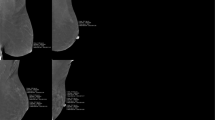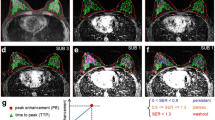Abstract
Objectives
To investigate effects of menopausal status, oral contraceptives (OC), and postmenopausal hormone therapy (HT) on normal breast parenchymal contrast enhancement (CE) and non-mass-like enhancing areas in magnetic resonance mammography (MRM).
Methods
A total of 459 female volunteers (mean age 49.1 ± 12.5 years) underwent T1-weighted 3D MRM 1–5 min after bolus injection of gadobutrol. Quantitative analysis was performed in normal breast parenchyma by manually tracing regions of interest and calculating percentage CE. Semiquantitative analysis was performed in non-mass-like enhancing areas, and signal intensity changes were characterised by five predefined kinetic curve types. The influence of OC (n = 69) and HT (n = 24) on CE was studied using random effects models.
Results
Breast parenchymal enhancement was significantly higher in premenopausal than in postmenopausal women (P < 0.001). CE decreased significantly with the use of OC (P = 0.01), while HT had negligible effects (P = 0.52). Prevalence of kinetic curve types of non-mass-like enhancement differed strongly between pre- and postmenopausal women (P < 0.0001), but was similar in OC users and non-OC users (P = 0.61) as well as HT users and non-HT users (P = 0.77).
Conclusions
Normal breast parenchymal enhancement and non-mass-like enhancing areas were strongly affected by menopausal status, while they were not affected by HT use and only moderately by OC use.
Key Points
• Breast parenchymal enhancement at MR mammography is stronger in premenopausal than postmenopausal women.
• The prevalence of strong enhancing non-mass-like areas is greater before menopause.
• Such enhancing non-mass-like areas may impair lesion detection in premenopausal women.
• Breast parenchymal enhancement is only marginally affected by hormone use.
• Discontinuation of hormone use before MR mammography may be unnecessary.





Similar content being viewed by others
Abbreviations
- ATC:
-
Anatomical Therapeutic Chemical classification system
- BI-RADS:
-
Breast Imaging-Reporting and Data System
- BMI:
-
Body mass index
- CE:
-
Contrast enhancement
- HT:
-
Postmenopausal hormone therapy
- MRM:
-
Magnetic resonance mammography
- OC:
-
Oral contraceptives
- ROI:
-
Region of interest
- TWIST:
-
Time-resolved angiography with stochastic trajectories
References
Hauth EAM, Jaeger H, Maderwald S et al (2006) Evaluation of quantitative parametric analysis for characterization of breast lesions in contrast-enhanced MR mammography. Eur Radiol 16:2834–2841
Kuhl CK, Bieling HB, Gieseke J et al (1997) Healthy premenopausal breast parenchyma in dynamic contrast-enhanced MR imaging of the breast: normal contrast medium enhancement and cyclical-phase dependency. Radiology 203:137–144
American College of Radiology (2003) ACR Breast Imaging-Reporting and Data System (BI-RADS): breast MRI atlas, 4th ed. American College of Radiology, Reston, VA
Sardanelli F, Podo F (2007) Breast MR imaging in women at high-risk of breast cancer. Is something changing in early breast cancer detection? Eur Radiol 17:873–887
Jansen SA, Newstead GM, Abe H, Shimauchi A, Schmidt RA, Karczmar GS (2007) Pure ductal carcinoma in situ: kinetic and morphologic MR characteristics compared with mammographic appearance and nuclear grade. Radiology 245:684–691
Teifke A, Lehr H, Vomweg T, Hlawatsch A, Thelen M (2003) Outcome analysis and rational management of enhancing lesions incidentally detected on contrast-enhanced MRI of the breast. AJR Am J Roentgenol 181:655–662
Hambly NM, Liberman L, Dershaw DD, Brennan S, Morris EA (2011) Background parenchymal enhancement on baseline screening breast MRI: impact on biopsy rate and short-interval follow-up. AJR Am J Roentgenol 196:218–224
Baltzer PA, Dietzel M, Vag T et al (2011) Clinical MR mammography: impact of hormonal status on background enhancement and diagnostic accuracy. Rofo 183:441–447
Uematsu T, Kasami M, Watanabe J (2011) Does the degree of background enhancement in breast MRI affect the detection and staging of breast cancer? Eur Radiol 21:2261–2267
Pfleiderer SOR, Sachse S, Sauner D (2004) Changes in magnetic resonance mammography due to hormone replacement therapy. Breast Cancer Res 6:R232–238
Jansen SA, Lin VC, Giger ML, Li H, Karczmar GS, Newstead GM (2011) Normal parenchymal enhancement patterns in women undergoing MR screening of the breast. Eur Radiol 21:1374–1382
Chan S, Su M-YL, Lei F-J et al (2011) Menstrual cycle-related fluctuations in breast density measured by using three-dimensional MR imaging. Radiology 261:744–751
Hussain Z, Roberts N, Whitehouse GH, García-Fiñana M, Percy D (1999) Estimation of breast volume and its variation during the menstrual cycle using MRI and stereology. Br J Radiol 72:236–245
Graham SJ, Stanchev PL, Lloyd-Smith JO, Bronskill MJ, Plewes DB (1995) Changes in fibroglandular volume and water content of breast tissue during the menstrual cycle observed by MR imaging at 1.5 T. J Magn Reson Imaging 5:695–701
Dean KI, Majurin ML, Komu M (1994) Relaxation times of normal breast tissues. Changes with age and variations during the menstrual cycle. Acta Radiol 35:258–261
O’Flynn EAM, Morgan VA, Giles SL, Desouza NM (2012) Diffusion weighted imaging of the normal breast: reproducibility of apparent diffusion coefficient measurements and variation with menstrual cycle and menopausal status. Eur Radiol 22(7):1512–1518
Müller-Schimpfle M, Ohmenhaüser K, Stoll P, Dietz K, Claussen CD (1997) Menstrual cycle and age: influence on parenchymal contrast medium enhancement in MR imaging of the breast. Radiology 203:145–149
Delille J-P, Slanetz PJ, Yeh ED, Kopans DB, Garrido L (2005) Physiologic changes in breast magnetic resonance imaging during the menstrual cycle: perfusion imaging, signal enhancement, and influence of the T1 relaxation time of breast tissue. Breast J 11:236–241
Rieber A, Nüssle K, Merkle E, Kreienberg R, Tomczak R, Brambs HJ (1999) MR mammography: influence of menstrual cycle on the dynamic contrast enhancement of fibrocystic disease. Eur Radiol 9:1107–1112
Boyd NF, Melnichouk O, Martin LJ et al (2011) Mammographic density, response to hormones, and breast cancer risk. J Clin Oncol 29:2985–2992
Reichenbach JR, Przetak C, Klinger G, Kaiser WA (1999) Assessment of breast tissue changes on hormonal replacement therapy using MRI: a pilot study. J Comput Assist Tomogr 23:407–413
Delille JP, Slanetz PJ, Yeh ED, Kopans DB, Halpern EF, Garrido L (2005) Hormone replacement therapy in postmenopausal women: breast tissue perfusion determined with MR imaging—initial observations. Radiology 235:36–41
Völzke H, Alte D, Schmidt CO et al (2011) Cohort profile: the study of health in Pomerania. Int J Epidemiol 40:294–307
Hegenscheid K, Kühn JP, Volzke H, Biffar R, Hosten N, Puls R (2009) Whole-body magnetic resonance imaging of healthy volunteers: pilot study results from the population-based SHIP study. Rofo 181:748–759
Kaiser WA, Zeitler E (1989) MR imaging of the breast: fast imaging sequences with and without Gd-DTPA. Preliminary observations. Radiology 170:681–686
Snijders T, Bosker R (1999) Multilevel analysis: an introduction to basic and advances multilevelmodeling. Sage Publications, London
Hulka CA, Smith BL, Sgroi DC et al (1995) Benign and malignant breast lesions: differentiation with echo-planar MR imaging. Radiology 197:33–38
Hulka CA, Edmister WB, Smith BL (1997) Dynamic echo-planar imaging of the breast: experience in diagnosing breast carcinoma and correlation with tumor angiogenesis. Radiology 205:837–842
Zeppa R (1969) Vascular response of the breast to estrogen. J Clin Endocrinol Metab 29:695–700
Potten CS, Watson RJ, Williams GT et al (1988) The effect of age and menstrual cycle upon proliferative activity of the normal human breast. Br J Cancer 58:163–170
Teifke A, Hlawatsch A, Beier T et al (2002) Undetected malignancies of the breast: dynamic contrast-enhanced MR imaging at 1.0 T. Radiology 224:881–888
Neubauer H, Li M, Kuehne-Heid R, Schneider A, Kaiser WA (2003) High grade and non-high grade ductal carcinoma in situ on dynamic MR mammography: characteristic findings for signal increase and morphological pattern of enhancement. Br J Radiol 76:3–12
Marklund M, Christensen R, Torp-Pedersen S, Thomsen C, Nolsøe CP (2009) Signal intensity of normal breast tissue at MR mammography on midfield: applying a random coefficient model evaluating the effect of doubling the contrast dose. Eur J Radiol 69:93–101
Kulier R, Helmerhorst FM, Maitra N, Gülmezoglu AM (2004) Effectiveness and acceptability of progestogens in combined oral contraceptives—a systematic review. Reprod Health 1:1
Fujimoto J, Sakaguchi H, Hirose R, Tamaya T (1998) Sex steroidal regulation of vessel permeability associated with vessel endothelial cadherin (V-cadherin). J Steroid Biochem Mol Biol 67:25–32
Wang J, Jiang C, Li X, Liu C, Cheng N, Hao Y (2009) The protective mechanism of progesterone on blood-brain barrier in cerebral ischemia in rats. Brain Res Bull 79:426–430
Acknowledgements
SHIP is part of the Community Medicine Research Net of the University of Greifswald, Germany, which is funded by the Federal Ministry of Education and Research (grant No. 03ZIK012), the Ministry of Cultural Affairs as well as the Social Ministry of the Federal State of Mecklenburg-West Pomerania. Whole-body MR imaging was supported by a joint grant from Siemens Healthcare, Erlangen, Germany, and the Federal State of Mecklenburg-West Pomerania. The University of Greifswald is a member of the ‘Center of Knowledge Interchange’ program of Siemens AG. Dynamic contrast-enhanced MR mammography research is part of the entire whole-body MRI study and was supported by Bayer Healthcare.
Author information
Authors and Affiliations
Corresponding author
Rights and permissions
About this article
Cite this article
Hegenscheid, K., Schmidt, C.O., Seipel, R. et al. Contrast enhancement kinetics of normal breast parenchyma in dynamic MR mammography: effects of menopausal status, oral contraceptives, and postmenopausal hormone therapy. Eur Radiol 22, 2633–2640 (2012). https://doi.org/10.1007/s00330-012-2544-9
Received:
Revised:
Accepted:
Published:
Issue Date:
DOI: https://doi.org/10.1007/s00330-012-2544-9




